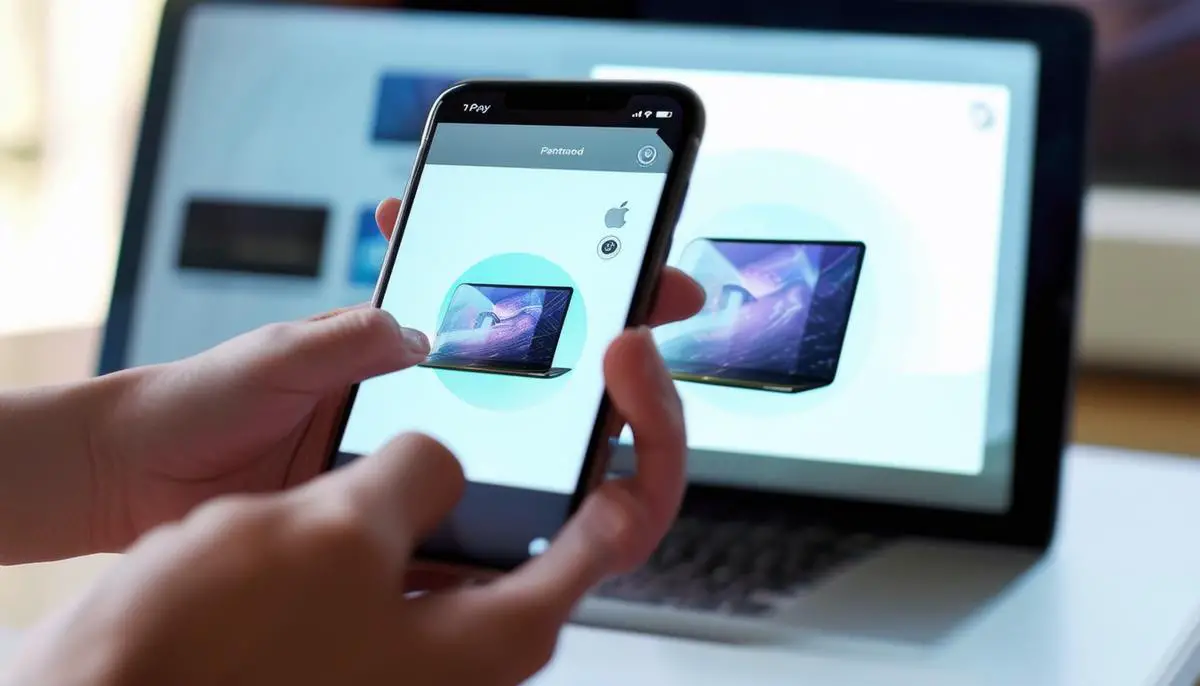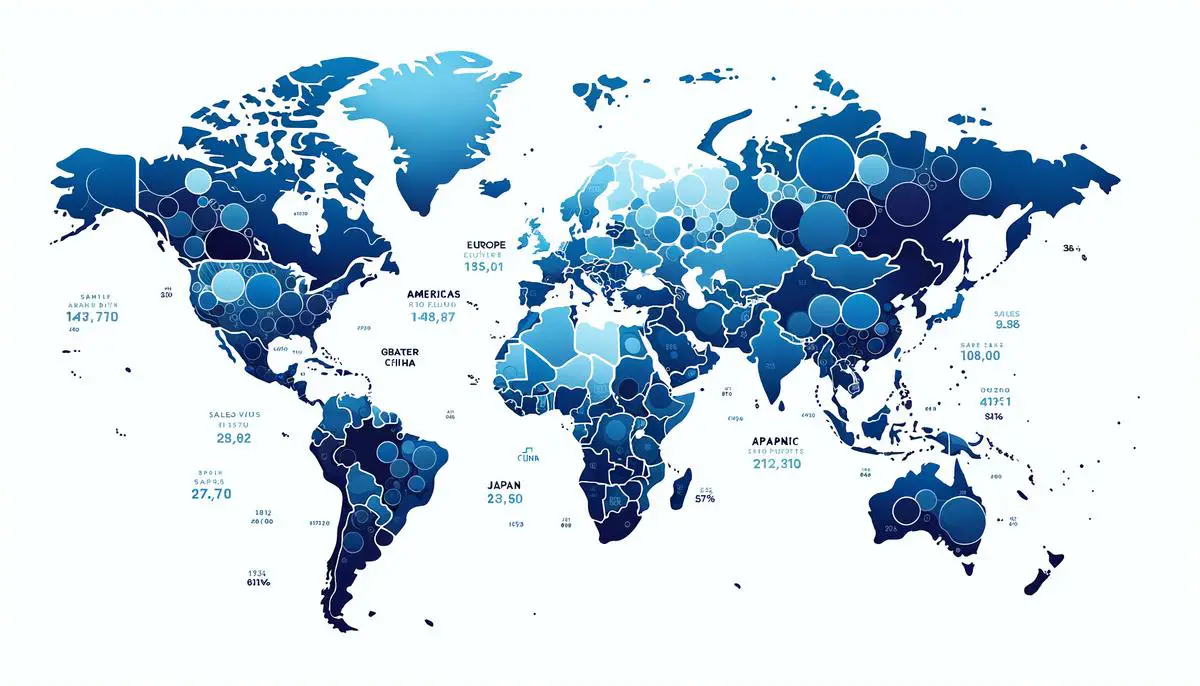Apple's Product and Service Sales Shifts
Apple's 2023 revenue of $383 billion showed a 3% decline, with iPhone sales dropping 2% to $201 billion. Mac revenue plummeted 27% to $29 billion, while iPad slipped 3% to $28 billion.
Services, however, grew 9% to $85 billion. This includes:
- iCloud
- App Store
- Apple Music
- Apple TV+
- Apple Fitness+
Apple Pay's rise boosted seamless transactions and security.
Wearables, home, and accessories brought in $40 billion, with AirPods and Apple Watch leading despite a 3.6% dip.
Geographically, the breakdown was as follows:
- Americas: $163 billion (4% drop)
- Europe: $94 billion (1% slip)
- Greater China: $73 billion (2% drop)
- Japan: $24 billion (highest margin at 49%)
Apple's shift from hardware to services is clear. This transition aims to keep users hooked, renewed, and revenue-fed in an expanding tech ecosystem.
Mobile Commerce and Social Media's Role
Apple's mastering the mobile commerce (mCommerce) and social shopping scene like a maestro. Their website and apps are mobile-devoted, offering a smooth, intuitive browsing experience. It's as if Johnny Ive himself sculpted the interface!
Integration with platforms like Instagram and TikTok takes Apple's mCommerce game to new heights. Influencers act as pied pipers, leading followers to the latest Apple marvels. Nearly 70% of Gen Z has no qualms about splurging on products directly through TikTok, and Apple's riding this wave with flair.1
Shoppable media transforms static images and videos into gateways for purchases. With every swipe, the Apple Store gets closer to your pocket. It's retail therapy on steroids, powered by Apple's ingenious adoption of mCommerce technologies.
The stats are jaw-dropping. In 2024, US mCommerce sales are projected to hit $542.73 billion – nearly half of all retail eCommerce sales. A whopping 91% of folks are making these purchases right from their smartphones.2
Apple's cutting-edge embrace of mCommerce and social shopping ensures their products and services are as accessible as they are desirable. The future of shopping is literally at your fingertips, with Apple leading the charge!
Technological Innovations in E-commerce
Apple Pay isn't just a payment method; it's a game-changer. With a flick of the wrist or a face scan, you're set to make a purchase. It's slashed cart abandonment rates and turned potential logistical nightmares into smooth sailing.
Augmented reality (AR) is another ace up Apple's sleeve. Curious how that new MacBook will fit on your cluttered desk? AR gives you a virtual view. This tech bridges the gap between hesitation and confident purchases, turning online shopping into an interactive adventure.
Advanced analytics are the secret sauce in Apple's personalization efforts. They're not just guessing what you might like; they're using big data to read your digital mind. The tailored product recommendations that pop up aren't random – they're data-driven strokes of genius.
Apple's e-commerce strategy isn't just about selling products; it's about crafting an experience that feels almost personal. Thanks to innovations like Apple Pay, AR, and advanced analytics, you're not just a customer – you're a central character in Apple's retail story.
Get ready for a future where innovation and commerce blend seamlessly, making every purchase feel like a small piece of magic. Apple's steering this ship, and the destination looks mighty exciting!

Geographic Differences in Apple Sales
Apple's global sales landscape is a mosaic of regional variances, each with unique economic and cultural flavors.
| Region | Revenue | Change | Notes |
|---|---|---|---|
| Americas | $163 billion | -4% | 36% of total sales |
| Europe | $94 billion | -1% | Strong brand love |
| Greater China | $73 billion | -2% | Complex market |
| Japan | $24 billion | N/A | 49% operating margin |
| Rest of Asia Pacific | $8 billion | +1% | Diverse region |
The Americas, Apple's crown jewel, raked in $163 billion in 2023 – nearly half of Apple's global revenue. Despite a 4% decline, the U.S. remains the titan of the Apple empire with a 36% share of total sales. Here, Apple's products are woven into the daily fabric of consumer life.
Europe, the second-largest market, added $94 billion with only a 1% slip. A blend of tech adoption and brand love keeps Apple strong here. The Middle Eastern market adds spice with high disposable incomes and a taste for luxury tech.
Greater China contributed $73 billion, despite a 2% dip. It's a complex battleground where Apple contends with local competitors and economic headwinds. The consumer here is tough – loyal yet discerning, craving innovation yet mindful of privacy.
Japan snagged $24 billion, boasting a whopping 49% operating margin. The market here blends tech enthusiasm with a cultural tilt towards quality and craftsmanship. Apple stands its ground against domestic competitors with unmatched elegance and capability.
The rest of Asia Pacific added $8 billion, with a modest 1% rise. This diverse region presents mixed opportunities and challenges, with Apple cleverly positioning its products to resonate with local tastes and economic conditions.
Across these regions, Apple's performance isn't just about marketing or tech – it's about adapting to local tastes, economic realities, and competitive landscapes. Whether you're in Tokyo or Texas, there's an Apple device that feels just right for you!

Apple's pivot from hardware to services is a masterstroke, redefining how we interact with technology daily. This transition sets the stage for a future where Apple's ecosystem becomes indispensable in our lives. It's not just about staying relevant; it's about shaping the tech landscape itself!
- Insider Intelligence. TikTok social commerce report 2023. eMarketer.
- Statista Research Department. Mobile commerce sales in the United States from 2018 to 2024. Statista.